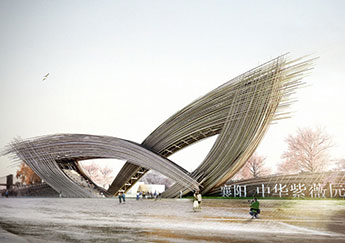Blossom Gate inspired by Chinese Calligraphy
Defining a landmark to the entrance of the largest Chinese myrtle garden in Xiangyiang, Prechteck’s ‘Blossom Gate’ aims to reinvent the gate as an architectural typology underlining the connecting characteristics of a former dividing element. Their design is not just about the link between the inside with the outside, but also about the connection with its visitors, the gate as an area of gathering, instead of a point of passing through.
Formalistic inspirations had been drawn from the Chinese tradition of calligraphy, the context and its topography and flower-blossoms as a theme for the garden. As a typology, the main function of a gate is a dividing one, separating the inside from the outside. On the other hand, a gate is also the only a connecting element, guiding people to a certain point, where the inside and the outside get unified.
The structure serves as a gate to the flower park of Xiangyang, a city famous for its nature, tradition, and writers. The design shows a tribute to those. Inspired by the shape of a flower, two blossoms define the gate, honouring the beautiful landscape of the area. As the structure arches over, bundles of bamboo on the outside create a majestic volume of light in the ‘in-between space’. This space not only serves the flower garden as an entrance gate and meeting point for visitors, but also can be used as a sheltered void which serves the community for concerts or lectures. From the outside, the Blossom Gate is a symbol for unity and harmony and for sure a desired background for wedding pictures in the flower garden.
As a brush fades out at the end of each stroke, the gate also is defined by this beauty of a non-perfect, non-continuous line connecting the building to its heritage and to the tradition of Chinese calligraphy the city is famous for. The project is expected to be completed in 2013.

